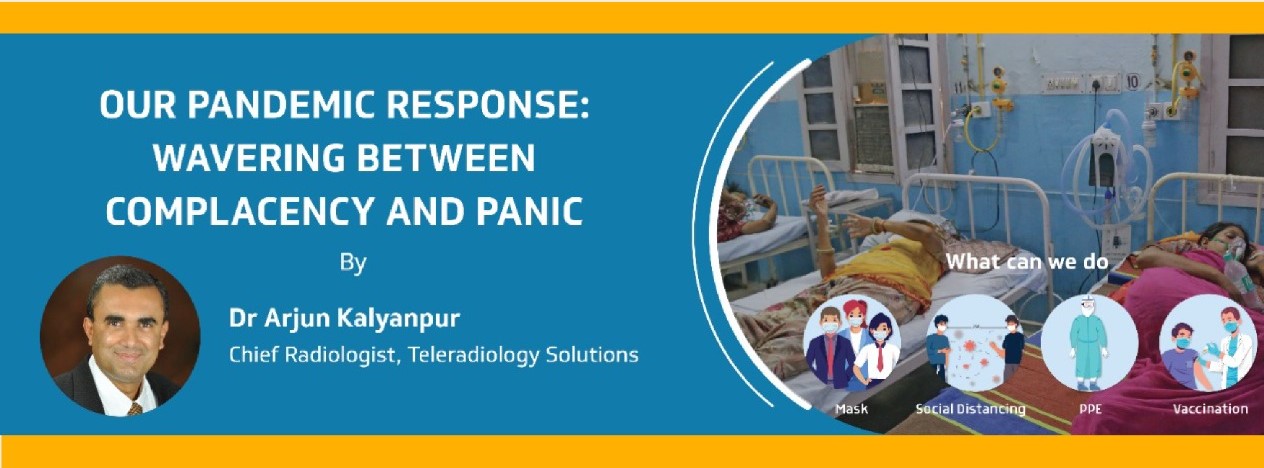As India emerges from a second COVID wave of extreme ferocity, the overwhelming reaction has been one of disbelief. How could things have gotten so bad so quickly? Not so very long ago, all had seemed completely normal to the extent that all routine activities including sporting events, weddings, movie theatre screenings etc had been resumed. Even large gatherings were being conducted with aplomb. Then suddenly, in the space of a few weeks we found ourselves in a panic state with overflowing hospitals and oxygen shortages. And then eventually and inevitably, the return of the lockdown. Today, as the situation slowly improves, what learnings can we derive from the recent trauma we have collectively been through?
One biologic reason for our finding ourselves in this mess, (and this is certainly not unique to any one country) is related to our human response to stress – which is also termed as Fight or Flight. In essence, as a species, we are biologically and endocrinologically programmed to remain in a default state of relaxation, until such time as danger appears, at which point our adrenal glands kick in with a stiff dose of adrenaline that activates an emergency activation response that jolts us into action. Think of the gazelle on the African plain which is calmly grazing until such time as it spots the cheetah, at which point it is immediately activated into a high level of motion and energy. From an evolutionary standpoint we are not that far removed from the gazelle and so our natural tendency is to continue to ‘graze’ until such time as disaster stares us in the face. (Ironically, our response to global climate change is similar).
Another psychological trait that works against us during the pandemic is our tendency to suppress our most painful thoughts and memories, which then exposes us to the risk of facing the same issues and challenges over and over again. The expression public memory is short is deceivingly trite but profound in its implications. Although the news from countries such as Spain, Italy and even the US from a year ago made us fully conscious of the ravages the virus was capable of, we still were effectively able to convince ourselves that we were in some way immune or exempt from these challenges.
Finally, pandemic fatigue is another potent psychologic factor. The pandemic has brought with it a series of shocks and recurring waves of psychologic trauma … from the lockdowns, to the perpetual wearing of masks, the required use of PPE, social distancing, the constant presence of disease and death staring us in the face. Over a prolonged timeframe this has resulted in fatigue, exhaustion and anxiety. We have reached a point where we cannot wait to remove our masks, to embrace and shake hands, to socialize as we did before, and ultimately to engage in large group activities such as weddings, religious congregations, sporting events. This is a natural human psychologic response, which today, still needs to be curtailed or curbed in the interest of self-preservation.
So what weapons do we have, in this fight against our internal demons? The past year has shown us that neither extreme of reaction, namely continuing normal behavior in complete denial of the grim reality of the virus’ hazards, nor becoming cautious and paranoid to the point where it impacts on mental health, is appropriate. Essentially a happy medium is necessary, one where we continue to take all the recommended precautions and carefully engage in safe travel and social practices, in outdoor locations, incorporating social distancing, masking and now vaccination.
Today, vaccination is the only hope to rid us of this scourge. Vaccinating a large percentage of the community is key to reducing the proliferation of the virus within us human vectors. Sadly, a significant percentage of the population sees vaccination as risky and does not allow this to happen, by refusing to take the vaccine themselves and by vociferously dissuading others from taking it as well. By determinedly reassuring those who are receptive though concerned, a critical mass of vaccinees can be achieved to combat the virus’ spread.
In addition to embracing vaccination, we need to adopt a calmer approach to news and information, which, thanks to social media, swirls around us constantly like a miasma. Which of us has not felt that little sense of panic or that sinking feeling on getting the latest snippet of COVID-related bad news from the dismal Jonah on our high school Whatsapp group?
Next, we need to accept that we, every one of us, is part of the problem and also part of the solution. It doesn’t help to blame the government, the vaccine manufacturers, the public health system or the WHO. What we need to realize is that it is us who need to wear our masks properly (over the nose), eschew socializing in groups and take the vaccine if we are to liberate ourselves from the virus.
And most important, what we need is to think long term, and not have a knee-jerk response to COVID, which thrives in the face of human chaos and unpreparedness. The main learning should be that we need a measured and long term strategy to deal with the Coronavirus, if we are to truly conquer it. We need to be prepared to sacrifice instant gratification for long-term security. We need to be calm, positive and deal practically with the situation that faces us. Essentially we must neither panic nor be complacent. In the ageless words of the Latin writer Publilius, ‘Equanimity is calamity’s medicine’.

